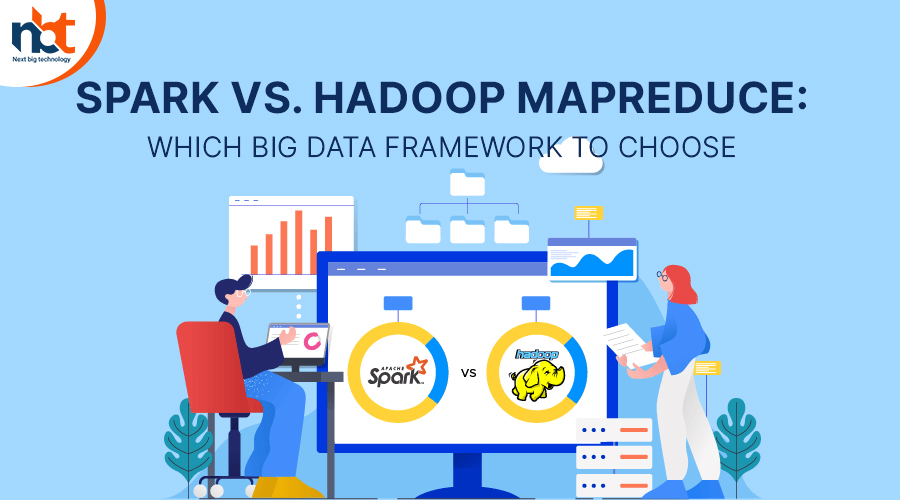With so many big data frameworks on the market, picking the correct one can be difficult. Businesses should assess each framework from the perspective of their own needs, rather than using the traditional method of comparing the benefits and drawbacks of each platform. Our big data consulting experts evaluate Hadoop MapReduce vs. Apache Spark to address a critical question: which choice to choose – Hadoop MapReduce or Spark.
Table of Contents
A short assessment of the current market condition
Hadoop and Spark are both Apache Software Foundation open-source projects and the main tools in big data analytics. For more than 5 years, Hadoop has dominated the big data business. According to our recent industry analysis, Hadoop has over 50,000 clients, whereas Spark only has over 10,000. Spark’s popularity, on the other hand, soared in 2013, surpassing Hadoop in less than a year. The trend is still going strong, according to a new installation growth rate (2016/2017). Spark outperforms Hadoop by 47 percent versus 14 percent, respectively.
We’ll contrast Spark with Hadoop MapReduce to make the comparison fair, given both are responsible for data processing.
The main distinction between Hadoop MapReduce and Spark is that Hadoop MapReduce is a distributed computing system, whereas Spark is
In truth, the primary difference between Hadoop MapReduce and Spark is the processing approach: Spark can process data in memory, whereas Hadoop MapReduce must read from and write to a disc. As a result, processing speed varies greatly – Spark might be up to 100 times faster. The amount of data that can be processed, on the other hand, varies: Hadoop MapReduce is capable of handling far bigger data sets than Spark.
Let’s take a deeper look at the jobs that each framework is capable of performing.
Hadoop MapReduce is useful for the following tasks:
- Massive data collections are processed in a linear fashion. Hadoop MapReduce allows massive volumes of data to be processed in parallel. It divides a large chunk into smaller pieces, which are processed separately on different data nodes, and then automatically collects the results from all of them to produce a single result. Hadoop MapReduce may outperform Spark if the generated dataset is larger than available RAM.
- If no quick results are expected, this is a cost-effective solution. If processing speed isn’t crucial, MapReduce is a decent option, according to our Hadoop team. If data processing can be done during the night, for example, Hadoop MapReduce should be considered.
Spark is useful for the following tasks:
- Data processing is quick. Spark outperforms Hadoop MapReduce by up to 100 times for data in RAM and up to 10 times for data in storage because of in-memory processing.
- Processing is done in stages. Spark defeats Hadoop MapReduce when the task is to process data repeatedly. Spark’s Resilient Distributed Datasets (RDDs) allow numerous map operations to be performed in memory, whereas Hadoop MapReduce requires interim results to be sent to disc.
- Processing in near-real-time.If a company requires quick answers, Spark and its in-memory processing are the way to go.
- Processing of graphs. The computational paradigm of Spark is well suited to iterative computations, which are common in graph processing. GraphX is an API for graph processing in Apache Spark.
- Machine learning is a term that refers to the study of. Spark comes with MLlib, a built-in machine learning library, whereas Hadoop requires a third-party library. Out-of-the-box algorithms in MLlib execute in memory as well. However, if necessary, our Spark experts will modify and alter them to meet your specific requirements.
- Datasets are joined together. Spark can produce all combinations faster due to its speed, yet Hadoop may be superior if you need to join very huge data sets that require a lot of shuffling and sorting.
Examples of real-life scenarios
We examined a variety of real-world scenarios and concluded that Spark is likely to beat MapReduce in each of the applications listed below, owing to its near-real-time processing. Now, let us consider a few specific examples.
- Segmentation of customers. Businesses may better understand client preferences and provide a unique customer experience by analyzing customer activity and identifying categories of customers that have similar behavior patterns.
- Risk management is the management of risks. Forecasting several probable situations can assist managers in making the best judgments possible by avoiding risky options.
- Detection of fraud in real-time. After the system has been educated on historical data using machine-learning techniques, it can utilize the results to detect or forecast anomalies in real-time that could indicate fraud.
- Analysis of big data in the industry. It’s also about recognizing and anticipating anomalies, but these anomalies are tied to mechanical breakdowns in this case. Sensor data is collected by a correctly equipped system to detect pre-failure circumstances.
Which framework should you use?
The framework you choose should be based on your specific business demands. Hadoop MapReduce offers linear processing of large datasets, but Spark offers fast performance, iterative processing, real-time analytics, graph processing, machine learning, and more. Spark may outperform Hadoop MapReduce in many circumstances. The good news is that Spark is completely compatible with the Hadoop environment and integrates seamlessly with the Hadoop Distributed File System, Apache Hive, and other Hadoop components.
Thanks for reading our post “Spark vs. Hadoop MapReduce: Which is better?”, please connect with us for any further inquiry. We are Next Big Technology, a leading web & Mobile Application Development Company. We build high-quality applications to full fill all your business needs.




















